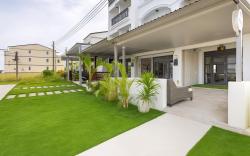Duzai Ping Introduction
The most attractive tourist resource in Little Liuqiu is undoubtedly the intertidal zone tours. During low tide, the Duzai Ping intertidal zone becomes a gathering spot for visitors exploring the fascinating marine ecology, where everyone can discover astonishing creatures in this area. However, getting to Duzai Ping is not so easy; first, you have to pass through a rugged dirt path overgrown with grass from the hillside to reach the coast, so it is advisable to have a local guide for safety! After low tide, Duzai Ping may seem calm, but it actually harbors a wealth of life. At this time, it's essential to use your sharp eyes to closely observe the movements in the coral reefs and pools and see how many marine creatures you can spot. In addition to being a great place to observe the intertidal zone, Duzai Ping is also a perfect spot to enjoy the sunset. The orange-red sun reflects in the pools of the intertidal zone, coloring the entire tide, making this stunning view a scene that often makes people stop and admire.






























